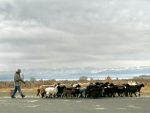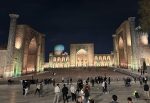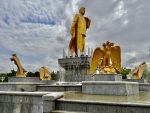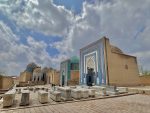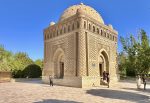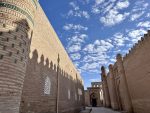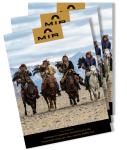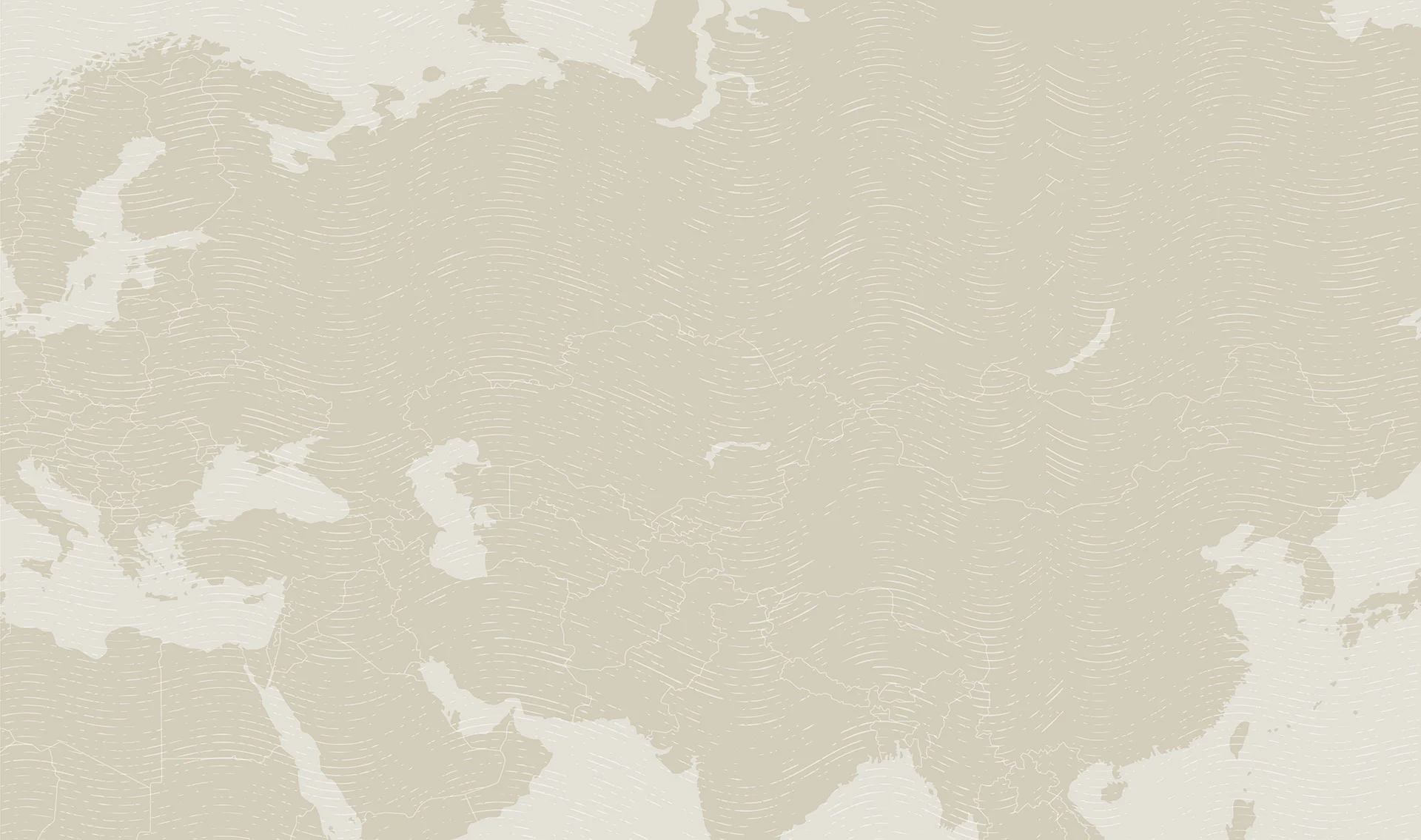Journey Through Central Asia: The Five ’Stans
Photo credit: Michel Behar
A Classic Silk Road Survey
Overview
The “5 ‘Stans” of Central Asia – Kazakhstan, Kyrgyzstan, Tajikistan, Turkmenistan, and Uzbekistan – are a treasure trove of history, culture, and natural beauty. Marvel at the ancient cities of Samarkand and Bukhara, admire the majestic mountains of Kyrgyzstan, and explore the stunning capital of Turkmenistan. More than 2,000 years ago, the great trade routes linking Europe and China opened Central Asia to foreign cultures, customs, and religions. Join a modern-day caravan on an epic journey to five of these exotic countries.
Travels to: Kazakhstan, Kyrgyzstan, Uzbekistan, Tajikistan, Turkmenistan
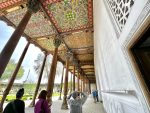
Map

Itinerary
-
Days 1-5: Almaty (Kazakhstan), Lake Issyk-Kul (Kyrgyzstan), Bishkek

Begin in and around Almaty, the quickly modernizing business capital of Kazakhstan, beautifully situated amid the majestic Tien Shan mountain range. Cross into Kyrgyzstan and spend two nights at beautiful alpine Lake Issyk-Kul before exploring Kyrgyzstan’s capital, Bishkek.
HIGHLIGHTS
- Central Almaty’s Panfilov Park, home to the candy-colored Zenkov Cathedral
- A demonstration of traditional Kazakh falconry in the Tien Shan foothills
- A boat ride on Lake Issyk-Kul
- Iron Age petroglyphs at Cholpan-Ata, near Lake Issyk-Kul
- Burana Tower, one of few remaining Silk Road watchtowers in Kyrgyzstan
- In Bishkek, an evening performance of selections from the Epic of Manas, a traditional Kyrgyz poem
-
Days 6-8: Osh, Fergana (Uzbekistan), Margilan, Rishtan, Khujand (Tajikistan)

Fly to Kyrgystan’s second-largest city, Osh, located in the lush Fergana Valley, which spans three of the five ’Stans. From there ascend UNESCO-listed Sulaiman-Too Sacred Mountain, one of the holiest Islamic sites in Central Asia. In the Uzbek portion of the valley, visit Margilan and Rishtan, villages specializing in silks and ceramics. Cross the border into Tajikistan for an overnight in historic Khujand.
HIGHLIGHTS
- Sulaiman-Too Sacred Mountain, an Islamic holy site known as “Little Mecca”
- Visits to Margilan’s market and the workshop of one of its silk makers
- Lunch and a workshop tour with a ceramics master in Rishtan Village
- Khujand’s huge, pink Panjshanbe covered bazaar
-
Days 9-17: Tashkent (Uzbekistan), Samarkand, Bukhara, Khiva, Nukus

The Uzbek portion of the trip starts in the capital of Tashkent and then devotes seven nights to three spectacular UNESCO-listed Silk Road oasis cities: blue-tiled Samarkand, once Tamerlane’s seat of power; Bukhara, site of the 2,000-year-old Ark Citadel; and Khiva, with its classic winding alleys and distinctive dun-colored walls. Then travel through the Kyzyl Kum (Red Sands) desert to the remote city of Nukus, the unlikely home of the world-class Savitsky Museum of avant-garde Russian art.
HIGHLIGHTS
- The wide, tree-lined boulevards of modern Tashkent
- Samarkand’s Registan Square, bordered by three beautiful madrassahs
- The 14th century conqueror Tamerlane’s architectural legacy in Samarkand, including Bibi Khanum Mosque, the largest of its day, and Ulug Bek Observatory
- Old Bukhara’s ageless domed bazaars and its central Lyab-i-Hauz Plaza, adorned with a reflecting pool
- Ark Citadel, Bukhara’s huge 2,000-year-old fortress
- Khiva’s Old Town, known as Ichon-Qala, a “living museum” that looks much as it did centuries ago
- Tash-Hauli Palace and Dzhuma Mosque, two of Khiva’s most impressive structures
- Savitsky Art Museum, the world’s second largest collection of Russian avant-garde art
-
Days 18-22: Kunya Urgench (Turkmenistan), Dashoguz, Ashgabat, Nisa, Merv

Cross into Turkmenistan and visit the UNESCO-listed Old Town of Kunya Urgench, then board a flight to the capital, Ashgabat, a city of flamboyant gilded architecture born from the rubble of a massive 1948 earthquake. A four-night-stay there includes day trips to two UNESCO-listed ancient cities: Nisa, once capital of the Parthian Empire; and Merv, an oasis that supported human life as far back as the Iron Age.
HIGHLIGHTS
- Kunya Urgench’s 11th century Kutlug-Timur Minaret, standing 190 feet tall and decorated with intricate mud brickwork
- The opulent new architecture of Ashgabat, which holds a Guinness record for highest density of white marble buildings in the world
- The $100-million Kipchak Mosque, with its 164-foot golden dome and room for 10,000 worshippers, located just outside Ashgabat
- The ruins of Nisa’s two fortresses, which show influences of ancient Greek and Roman culture
- A trip outside Ashgabat to a farm that breeds renowned Akhal-Tekke horses
-
Optional Post-Tour to Darvaza Crater

Stay a little longer and venture across the desert landscape north of the capital to the Darvaza Gas Crater, one of Turkmenistan’s most unusual sights. Remnants of the Soviet era, one of the craters has been set alight and blazes with an incredible strength that’s visible from miles away. The fire crater is best seen at night, so spend the night in a comfortable yurt camp here, before heading back to Ashgabat the next morning.
HIGHLIGHTS
- Flaming gas crater that has been burning for 30+ years
- Take in the night’s crystal clear stars in this remote desert environment
Dates & Prices
Small group tour – max 16 travelers
Land tour price, per person. Based on double occupancy and minimum group size of 5 travelers.
-
2026 Dates
Apr 5 - 26Limited space remains!Apr 12 - May 3Sold out departure, waitlist spots available!Apr 26 - May 17Newly added departure!May 3 - 24Extremely limited space remains.Aug 23 - Sept 13Newly opened departure!Sept 13 - Oct 4SOLD OUT! Taking waitlist bookings only.Sept 20 - Oct 11Newly opened departure!Oct 4 - 25Space is filling fast!Oct 11 - Nov 1Limited space remaining, call now!Tour, double occupancy$8,995Plus internal airfare$380Single supplement$1,495
-
2027 Dates
Apr 4 - 25Apr 11 - May 2Sept 12 - Oct 3Oct 3 - 24Oct 10 - 31Tour, double occupancy$8,995Plus internal airfare$400Single supplement$1,495
What's Included
-
Tour Includes
- Accommodations, as noted in the itinerary.
- Most meals, as noted in the itinerary: 21 breakfasts, 20 lunches and 16 dinners.
- Bottled water at group meals.
- Restaurant tips for included meals.
- Services of experienced, English-speaking local guides, drivers and other staff, including a MIR Tour Manager.
- Arrival/departure airport transfers. MIR will arrange for all travelers to be met on arrival and seen off on departure whether we make your airfare arrangements or not, provided you arrive and depart on the tour start/end dates in the tour start/end cities.
- Ground transportation throughout itinerary by private coach or van (size of vehicle depends on group size).
- Guided sightseeing tours and entrance fees as outlined in itinerary.
- Special events, excursions and cultural performances per the itinerary.
- Baggage handling where available.
- Gratuities to local guides, drivers, porters and other service personnel.
- Complete pre-departure electronic document that includes detailed packing suggestions, reading list links, country-specific information, maps, travel tips and more.
- Customized visa application and instruction kit (please note, visa fees are not included in the tour price).
- Electronic final update bulletin, with any late news, updates and important information.
-
Not Included
- Internal airfare (internal airfare is quoted separately and is subject to change by airlines).
- International airfare or taxes/fuel surcharges.
- Meals not specified as included in the itinerary.
- Single supplement charge, if requested or required.
- Items of a personal nature (phone calls, email, laundry, alcohol, excess baggage, etc).
- Gratuities to Tour Manager.
- Visa/passport fees, airport departure fees.
- Expenses incurred as a result of delay, modification or extension of a tour due to causes beyond MIR’s control.
- Travel entry pass to Turkmenistan payable on arrival, currently $12-$15, subject to change.
- Travel and trip cancellation insurance.
Activity Level
-
Level 3: Medium
Level 3: Medium
This small group tour features long days walking and standing while touring, several long days of overland travel (some on poor quality roads), lengthy foot traverses of two border points while rolling your own luggage (with occasional carrying), unpaved sidewalks and streets, uneven surfaces and steps, absent handrails, significant stair-climbing, and absence of elevators. Only those fit to travel and who are willing to accept local standards of amenities and services, and the physical challenges, should consider joining this program.
Travelers must be able to walk at least two miles a day, keeping up with fellow travelers. A few drives on poor-quality roads may last as long as 8-10 hours driving time (with comfort stops). Some border crossings may require walking up to about a half-mile while managing your own baggage. Bags can generally be rolled during border crossings, but may have to be carried short distances in the case of uneven surfaces or a few steps up or down during the crossing.
There are overall shortcomings in the tourism infrastructure of these developing destinations, including some that can cause walking challenges such as unpaved sidewalks, uneven surfaces and steps, packed-dirt streets, broken pavement (streets or sidewalks), and a general absence of handrails or ramps. Some attractions are only accessible via steep staircases with tall uneven steps – these can also be spiral staircases and/or in narrow passages with limited light. Elevators are not available at touring sights, nor at a few of the hotels.
Past travelers have also encountered challenges with plumbing, bureaucratic service, variety of locally available foods, and availability and quality of public restrooms.
Accommodations vary from three to five star properties, to relatively basic and simple (while still best-available) hotels in the more remote cities.
